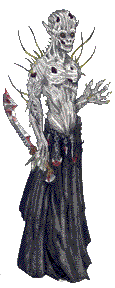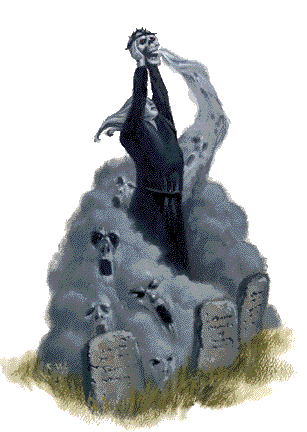| |




|
 |
 |
 |


The Evil Within
|
by Todd Laing
October
24th, 2003
All of us have trod the evil side of gaming at least once –
experimenting with the darker side of our characters in the quest
for gold, power, and fame. Who among us can deny the thrill of
controlling a horde of moldering flesh, the delectable taint of a
cursed item, or the sheer rapture when a maniacal plot takes hold?
Likely very few. By their collective nature gamers are
experimenters, trying on new personalities much as ‘normal’ people
try on new articles of clothing. We window shop until we see
something that steals our attention, forcing us to try it on. We don
that personality, checking the fit, the color, and whether it
clashes with the morals of our spouses or parents too badly. If it
is acceptable, we wear it awhile and flaunt it for all to see.
 But were
does this take us? Charles Darwin theorized that all things exist
because nature selected that trait as being beneficial—or at least
not detrimental to the existence of a species. The same can be
claimed for the gaming community . . . evil has a purpose. The most
obvious use is to propel the forces of good (read: PCs) to disrupt
the evil intensions of malefactors (read: NPCs). It is a formula
older than the written word. In fact, most aspects of our daily
lives entail the conflict and resolution of one thing against
another. But were
does this take us? Charles Darwin theorized that all things exist
because nature selected that trait as being beneficial—or at least
not detrimental to the existence of a species. The same can be
claimed for the gaming community . . . evil has a purpose. The most
obvious use is to propel the forces of good (read: PCs) to disrupt
the evil intensions of malefactors (read: NPCs). It is a formula
older than the written word. In fact, most aspects of our daily
lives entail the conflict and resolution of one thing against
another.
In a game, the struggle of good versus evil is the basic motive
behind most player decisions. If given a choice between confronting
a baker who is having a bad day and the mighty necromancer
inhabiting the local graveyard, the necromancer wins hands down.
Why? Well, the instruments of good are meaningless without the
activity of evil. Without the depredations of the foul zombie lord,
the heroes are somehow less noble, less complete. The converse is
also true. Evil without the interference of good-minded interlopers
is somehow less detestable, less malign. Good and evil need each
other to define their existence and give purpose.
This conflict is enjoyed and celebrated at thousands of gaming
tables every weekend. However, it is the unusual applications of
evil that are often overlooked and deserve more attention. One such
application is also the fondest memory I possess from DMing, when
through inspired evil I initiated the slow disintegration of the
party’s paladin into a raging maniac. I used no magic items. No
curses. I did not even nudge him along the dark path. It was a trip
is took on his own . . . all I did was show him the way.
In the beginning, he was a paladin like any other. Stemming from
noble stock he was respected and venerated, but also slightly
arrogant and aloof. The centerpiece of the party, he was the essence
of their glory and the director of their adventuring careers. Then,
on the chill November morning the door to the dark path was
irreversibly opened. It seemed so innocent at first, almost sweet
and tender. After a particular grueling encounter in which he almost
perished, the paladin simply stated that he wanted to go home to see
his parents. Being the de facto authority of the party, they
acquiesced and the journey began.
Now of course, I had no idea what his parents were like, or the
nature of their relationship with their son – so I did what good DMs
everywhere do, I punted. I conducted myself under one presumption:
Lawful Good is as an extreme alignment as Chaotic Evil. While CE is
certainly the least desirable alignment for your neighbor to have,
LG bears a similar taint and can make life miserable for
nonconformists. Thus ideologically positioned, I began to construct
the paladin’s parents.
Stalwart adherents to the Neutral view of life, they viewed
their son as a wayward soul, misbegotten and misguided. He was a
follower of drastic ideals he felt justified imposing on others. For
them there was no distinction between this radicalism and the
savagery of madness. Unbeknownst to the paladin, so shamed were his
parents over the current state of their son that they took pains to
strip their lives of evidence of his existence. Upon his arrival at
their manor, their reception was distant and disturbingly devoid of
warmth.
Needless to say, the paladin was very confused, uncertain why
his supposedly loving parents were separating themselves from their
heroic progeny. They confessed their feelings to him in a tense
meeting he insisted on. To the disgust of the paladin, he also
learned that his old chambers had been given to his cousin, Humphrey
. . . a fledgling necromancer. Enflamed, he demanded to know how
they could do such a thing. After all, Humphrey was a minion of
death and a blemish to the solid family name. How could they prefer
to support his cousin’s lifestyle while disparaging his own?
This simple beginning, this simple conflict, tore the soul from
the paladin. The damage was slow in coming, taking place over a
dozen more levels and a series of interconnecting adventures with
Humphrey as the plot device. At first, the existence of the
necromancer was an irritant to the paladin and a disdainful
amusement to the party. A squat, toad-like individual, Humphrey was
the object of derision and ridicule for the party for his lisping
speech and patently bizarre mannerisms. He was the ‘evil that could
do no wrong,’ a curious bone tossed out to titillate the players.

That viewpoint changed as Humphrey began to mature as good NPCs
do. Spurred by their disdain, the budding necromancer made his
irritating presence felt at every turn. He paraded his superior
position within the family and took pains to slander the paladin
whenever possible. His impact increased in pace with the animosity
felt for him. When the paladin could no longer conceal his hate, I
put Humphrey into action. With a dose of poisonous perfume he slew
everyone in the paladin’s favorite inn and fled to pursue a life of
true evil.
Oh, how the paladin felt justified. Expecting to be returned to
the bosom of his parents, he was shut out completely. It was, after
all, his endless badgering that led to this fate. The paladin and
the actions of his friends brought about the fell fate of many. Cast
out of his family, the paladin swore to hunt his cousin unto death.
From this point on, the paladin acted solely on emotion and not
reason. Shucking aside all attempts by his compatriots to blunt his
anger, the paladin descended into madness.
The adventures intensified with Humphrey ever the center of the
paladin’s obsession. If he expected that Humphrey was involved in
some uncovered plot, I altered it to make it so. I fed his
expectations until the necromancer was seen behind every tree,
boulder, and cloud. The paladin wanted Humphrey to be the cause of
all evil . . . and I obliged. I fed fuel to the fires of hate and
offered the paladin opportunities to thwart his foe. The cost, of
course, was his belief and faith.
The struggle was as one ripped from the pages of a Greek
tragedy. Consumed by hatred, the paladin vacated his holy vows in
order to hunt his cousin in a manner inclined to victory. Now as
brutal and base as the necromancer he had created, the ex-paladin
confronted Humphrey in the party’s last session. The battle was
long, but in the end the once-paladin fell with a whimper to his
cousin’s fell magic. Stripped of his dignity, morality, ethics, and
birthright, the character passed from life and into oblivion, the
abject example of vanity and the evil it wrought.
The lesson was clear to all at the gaming table. Evil is housed
in many forms and in a multitude of guises. But the most insidious
is the one brought to the table with the players. Bias and prejudice
are the weakness of all of us, and that is reflected in the
characters we play. Realizing this, I simply allowed the paladin to
guide himself to his fate. He needed a great evil to battle to
justify his presence and I gave it to him. He wanted power to thwart
that evil and I gave it to him. He longed for the titanic battle to
seal his legacy and I gave it to him. And though the outcome was not
expected, its rewards were great. Everyone had fun. A memorable
campaign was executed and completed. The players got everything they
wished for, though not in the fashion they imagined. And my friends
and I have stories to share for years to come.
You can view all of the previous columns by clicking
here.
|
|


 But were
does this take us? Charles Darwin theorized that all things exist
because nature selected that trait as being beneficial—or at least
not detrimental to the existence of a species. The same can be
claimed for the gaming community . . . evil has a purpose. The most
obvious use is to propel the forces of good (read: PCs) to disrupt
the evil intensions of malefactors (read: NPCs). It is a formula
older than the written word. In fact, most aspects of our daily
lives entail the conflict and resolution of one thing against
another.
But were
does this take us? Charles Darwin theorized that all things exist
because nature selected that trait as being beneficial—or at least
not detrimental to the existence of a species. The same can be
claimed for the gaming community . . . evil has a purpose. The most
obvious use is to propel the forces of good (read: PCs) to disrupt
the evil intensions of malefactors (read: NPCs). It is a formula
older than the written word. In fact, most aspects of our daily
lives entail the conflict and resolution of one thing against
another. 
